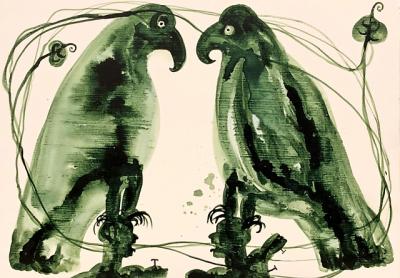Migration, Race, and Mobility Explored at the Parrish

Since moving into its building in Water Mill in 2012, the Parrish Art Museum has invited one artist each year to create works that respond to and utilize its spaces and grounds in innovative and provocative ways.
This year’s Platform exhibition, which will open Sunday, features the work of Barthélémy Toguo, an artist from Cameroon whose multidisciplinary projects explore issues of migration, mobility, colonialism, race, and the relationship between the global north and south.
“The Beauty of Our Voice” is Mr. Toguo’s first solo exhibition in an American museum, following his installations at biennials in Venice, Havana, and Sydney. In addition, he recently concluded a six-week residency at the Watermill Center, where he developed some of the work on view at the Parrish.
The centerpiece of the exhibition is “Road to Exile,” an installation that addresses the desire of young Africans to escape to a better life abroad. A life-size boat Mr. Toguo built at the Watermill Center is loaded with bags made of African fabrics and placed on a bed of glass bottles, whose fragility suggests the danger of the journey. “Road to Exile” will be juxtaposed with drawings, etchings, and paintings from the Parrish’s collection that depict boats in different eras and settings.
“Mobile Cafeteria” will transform another of the museum’s galleries into a participatory installation inspired by African street cafes. Mr. Toguo built furniture for the space, where visitors can play African board games, watch recorded African soccer matches, and learn about Bandjoun Station, a center for art, culture, education, and agriculture founded by the artist in Cameroon in 2007.
“Mobile Cafeteria” will also include artwork that explores socio-political issues in Africa and America, including “Black Lives Matter,” a series of pencil drawings of African-Americans recently killed in the United States by police, and “Stupid African President,” three nearly life-size photographs of the artist posing as African politicians.
Mr. Toguo, who divides his time between Paris and Bandjoun, Cameroon, also engaged nearly 100 Hamptons residents for “Head Over Water — Hamptons,” for which young adults from local schools and the Shinnecock Indian Nation were asked to answer the question, “Where do I fit in in American society?” The answers are printed on postcards along with original work by the artist.
“Barthélémy Toguo: The Beauty of Our Voice” will be on view through Oct. 14.
